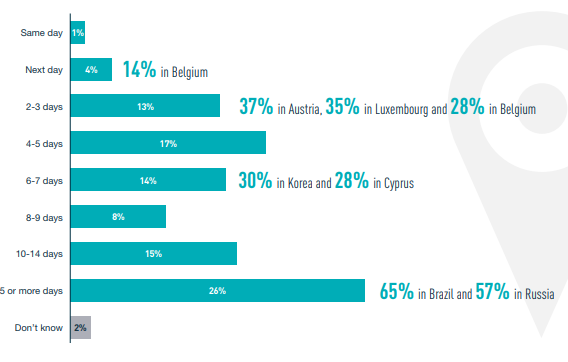What Cities Need to Accommodate the Delivery Economy

The shift to online retail has sent shockwaves through the shipping industry, turning a stagnant sector full of public companies into one where an increasing number of private firms understand the need to innovate and compete. Even as these businesses have responded with myriad new options, customer expectations continue to rise. Indeed, a recent poll of the world’s postal CEOs showed broad agreement that consumers will expect “much faster” shipping in the next five years.
Recent international polling agrees. About half of polled British consumers are less likely to shop with a seller if their delivery is late, and 68 percent of British retailers now offer next-day delivery. An International Post Corporation poll also found that consumers in many countries have come to expect only a two-to-three-day wait for an order to arrive, as the chart below illustrates.

The length of time customers expect to wait—the extensive or quantity margin—is determined largely by the overall speed of whisking packages across the globe. And such speed, of course, is the result of efficient logistics networks that are able to use economies of scale to move large volumes of parcels across the globe.
Further, according to the same poll, the top four aspects of a delivery that matter most, in order, are: clear delivery prices before purchase, reliable and free returns, and free delivery for orders over some value. These features represent the quality margin.
The price of delivery matters, but so does the experience of the order overall—from clear delivery options to a simple return process. Accordingly, retailers that make it needlessly difficult risk losing customers, even if the price is competitive with their peers.
For in-person transactions, the relationship between retailers and consumers looks like a quintessential market transaction. A seller names a price and a consumer purchases it if he finds that price acceptable. For online retail, however, public policy can play a bigger role in the way the logistics industry is shaped. To make deliveries faster, shippers need to be more efficient. And while technology and industrial relations are key here, so are more basic considerations, such as the locations of warehouses and distribution centers. For this reason, cities and states stand to gain if they get the rules that constrain warehouse development right.
After all, these facilities need large parcels of land with good highway access that inter-city trucks can get into and out of quickly. They must also be close enough to urban consumers to put goods on local delivery vehicles. Moreover, rising volumes of international purchases add pressure for these facilities also to be convenient to airports. Such needs are often hard to meet in urban environments, which are notorious for the limitations they place on building and land use. Industrial density is limited, parking requirements can be high, and large centrally located industrial parcels are sought out by residential, commercial, and institutional users.
Last year, shipper Prologis opened the first multistory warehouse in the United States. Such facilities are now a common sight in space-constrained Asian cities, and are a potential avenue to get more value out of urban industrial areas. To do so more extensively in the United States, however, planners need to modify existing rules that limit density on industrial lots.
Another potential difficulty that can be addressed through thoughtful public policy is delivery-related parking, which is also a major source of potential delay in high-traffic urban areas. Indeed, currently the ephemeral nature of delivery-truck parking can make the practice somewhat lawless. Trucks now regularly stop to deliver parcels on streets that they’d never spend time on in past decades. Further, underpriced street parking can make legal spaces an increasingly rare find. As a result, trucks frequently stop temporarily in travel lanes and park in illegal places to drop off and pick up.
To counter this culture, municipalities can deploy and enforce dedicated delivery vehicle loading zones. This would benefit consumers, online retailers, and local retail. With a loading zone on each block, shops and restaurants would have a place for their suppliers to park, while parcel companies avoid tickets and customers benefit from fewer late shipments.
As consumers expect faster and better shipping experiences, both logistics companies and policymakers must adapt. To do so, updating use rules for industrial land and street space are two concrete policy steps that would allow retailers and shippers to more easily accommodate a future where consumers rely on reliable, convenient shipping right to their front doors.
